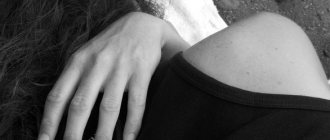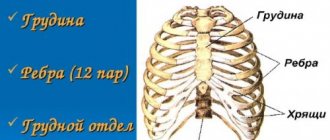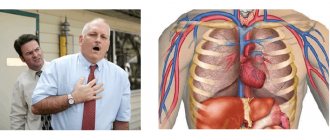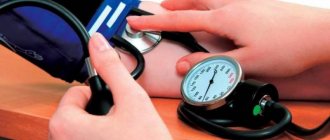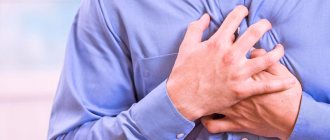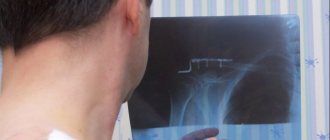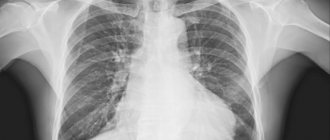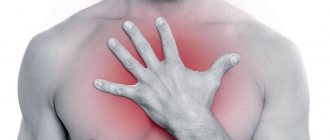Any pain is an invariable indication of a serious malfunction in the functioning of internal organs. But the pain in the chest and under the shoulder blade is especially unpleasant, limiting movement and forcing you to immediately put aside everything to get some rest. Most people associate discomfort in the chest with heart disease, especially if it is accompanied by other symptoms - loss of consciousness, darkening of the eyes, numbness in the limbs, etc. However, pain in the left side of the chest, radiating to the shoulder blade, can be associated with various diseases, including those not related to the functioning of the heart. Often unpleasant sensations are caused by diseases of the gastrointestinal tract, respiratory tract, neurological and psychological problems. The doctor will make an accurate diagnosis based on a description of the patient’s sensations, as well as the results of prescribed studies.
Heart problems
When pain occurs in the right side of the chest and under the right shoulder blade, the first suspicion falls on the heart. Diseases of this organ often cause discomfort in the chest.
Cardiac ischemia
Caused by impaired blood flow in the coronary arteries, which causes insufficient oxygen to enter the myocardium. Diagnosed quite often. In addition to pain symptoms, patients report shortness of breath, heart rhythm disturbances, and dizziness. Typically, these symptoms appear after intense physical activity - running, walking, sports exercises. The older the patient, the higher the risk of symptoms appearing when performing even simple housework. When the first warning signs appear, it is important to seek medical help as soon as possible. An accurate diagnosis can only be made after electrocardiography.
Acute myocardial infarction
It is determined by pain localized in the central and left part of the sternum. Pain can also be felt under the shoulder blade and in the left arm, where unpleasant sensations are transmitted due to nerve endings. If the patient does not pay attention to the pain and continues to move, the discomfort increases, accompanied by shortness of breath and increased body temperature.
Pain during a heart attack is wave-like, gradually increasing and decreasing, and covers a significant area of the body. Taking nitroglycerin has no effect on the patient's well-being. The faster help is provided, the higher the chances of recovery.
Cardiomyopathy
The disease is caused by changes in the structure and function of the heart muscle. It may be asymptomatic, but more often the disease is accompanied by pain in the left sternum and under the scapula. Taking heart medications is ineffective.
Heart valve defects
Thanks to the operation of the valves, blood flows into the heart and is pumped through the vessels. If defects develop in the tissues, the valves lose functionality. The movement of blood through the arteries becomes slower, and the organs do not receive enough oxygen. Stagnation of blood in the heart causes thickening of the heart muscle, causing it to become less elastic and inactive. A tingling or burning sensation in the sternum may indicate valve disease. Additional symptoms include:
- dyspnea;
- unnatural bright blush;
- blue discoloration of areas of the face or fingertips.
If you consult a doctor in a timely manner, you will be able to make a timely diagnosis and take measures to stabilize your heart function.
Pericarditis
Inflammation of the layers of the inner part of the heart leads to a partial loss of functionality of the heart muscle. Often, pericarditis is an additional symptom of cardiovascular disease. Pathology is indicated by pain in the sternum and under the shoulder blade, which gradually spreads to the left arm. The intensity of pain depends on the severity and characteristics of pericarditis. Taking analgesics temporarily numbs the pain, after which it reappears. An aggravation of unpleasant sensations occurs in a lying position, when coughing or swallowing.
Myocarditis
Inflammation of the heart muscle caused by allergies, infectious diseases, decreased immunity and other factors. Often the disease occurs without visible symptoms and is detected in the later stages of development. One of the main signs is discomfort in the area of the shoulder blade and nagging pain in the left arm, regardless of their intensity and duration. Additional signs that make it possible to clearly diagnose the disease are sweating, shortness of breath and a constant feeling of fatigue.
Treatment
Such painful sensations should not be tolerated. It is especially important to provide assistance to the patient as soon as possible if the pain is accompanied by shortness of breath, changes in blood pressure, fever, severe cough or nausea. In this case, it is recommended to consult a doctor. Medical assistance is also required if the pain continues for a long time, does not go away after taking painkillers, and is accompanied by numbness of the hands, weakness, and limited mobility.
Only when you are sure that the pain appeared after overwork or a chronic illness that the patient has been treating for a long time under the guidance of a doctor, you can try to relieve it yourself. For this, pain-relieving ointments are used, for example, Voltaren, Diclofenac, Dolgit, Fastum. Tablets containing analgesics or NSAIDs will also ease the patient's condition. It is recommended to take Ibuprofen, Nimesil, Ketanov, Baralgin and other drugs, but not more than 3-5 days.
If painful sensations are associated with pathologies of the spine, comprehensive treatment prescribed by a doctor is necessary. Therapeutic methods depend on the cause of the pain syndrome and are selected individually by a specialist. A back massage helps a lot, but it should be performed by a professional. It is also recommended to perform therapeutic exercises. After all, pain is often associated with muscle strain. Stretching or muscle relaxation exercises will help get rid of them.
A professionally performed massage will help relieve muscle spasms.
Drug treatment, in addition to painkillers, often also includes muscle relaxants, antispasmodics, vasodilators and multivitamins. Mydocalm, Sirdalud, Milgamma, Mexidol are especially often prescribed. In the presence of degenerative-dystrophic processes, chondroprotectors are effective. But you cannot choose your own medicine. Only a doctor after examination can determine which of them will be effective.
In addition to the treatment prescribed by your doctor, you can use folk remedies. The use of compresses, homemade ointments, and rubbing is effective.
You can use the following recipes:
- Beat 3 egg whites, add 50 g of dry mustard, vodka and camphor alcohol and leave for 10 hours.
- Mix 100 honey, 150 ml of vodka and 50 g of aloe juice, leave for 12 hours.
- Grate raw potatoes and a little horseradish, add a spoonful of honey.
- Prepare a vodka tincture of dandelion flowers in advance and use it to rub your back.
- A compress of grated black radish helps well with osteochondrosis, myositis, arthrosis, but it can only be applied through a cloth.
- Baths made from hay dust or sea salt are effective.
If such pain appears due to pathologies of the internal organs, you can only get rid of it by curing them. Therefore, the patient is treated by a cardiologist, pulmonologist or gastroenterologist. Most often it is taking special medications.
Other diseases that cause chest pain
The weakening of the blood vessel wall and its subsequent rupture has serious consequences for the body. An aneurysm occurs - a serious disease that can be congenital or acquired, for example, due to atherosclerosis or other diseases of the blood vessels. If an aneurysm affects the abdominal aorta or vessels in the sternum area, it is indicated by nagging, wave-like pain that gradually increases and slowly subsides.
Thromboembolism
A disease caused by a blockage of a pulmonary artery by a blood clot. The reason for its development is increased blood clotting and venous stagnation. The main symptom here is acute pain in the left side of the sternum, which is usually accompanied by shortness of breath, loss of consciousness, and a severe cough with bloody discharge. A patient in this condition requires immediate medical attention.
Respiratory diseases
The similarity of symptoms of cardiovascular and pulmonary diseases requires particularly careful diagnosis. Burning pain in the sternum, reminiscent of a heart attack, may clearly indicate pleurisy - inflammation of the pleural parts of the lungs. Unpleasant sensations intensify when coughing, walking, and also in a lying position. Patients complain of sputum and fever.
Diseases of the gastrointestinal tract
Diseases associated with the organs of the digestive system cause inflammation of their mucous membrane. As a result, patients feel severe pain in the abdomen, under the sternum and in the back.
Neurological disorders
Intercostal neuralgia
Intercostal neuralgia is more common than other diseases. This is the name for compression of the nerve endings in the ribs, which causes severe pain in the heart area, especially when moving and in an uncomfortable position.
Psychogenic cardialgia
The patient's complaints are associated with a certain feeling of compression or enlargement of the heart, which is accompanied by nagging pain in the sternum. The disease is predominantly psychological in nature, causing a person to suspect a serious heart pathology.
general characteristics
When your back hurts, it always causes serious discomfort to a person. But if the pain still radiates to the sternum, many patients begin to worry that they are connected to the heart. Anxiety makes the condition worse. Moreover, such a problem really often appears in heart failure. Therefore, it is very important to consult a doctor as soon as possible and undergo an examination, even if the pain is mild.
The pain in the spine may indeed not be very intense. If it is aching, occurs periodically during physical activity and goes away after rest, many people may not notice this problem. They believe that they are overtired and try to relieve discomfort with pain-relieving ointments or tablets. But the pain can also be strong, sharp, shooting or burning. They can intensify when turning the head, moving the arms, or coughing. If they are associated with pathologies of the digestive system, they will intensify after eating.
Pain between the shoulder blades is not a disease, but only a symptom of other diseases. Therefore, the therapeutic effect should not be on it, but on its cause. Often neither ointments nor injections help get rid of pain, because its source is in the internal organs. In this case, the patient's condition can only worsen.
Without treatment, periodic aching pain becomes constant. They can be sharp, burning, piercing, shooting. In addition, pain may radiate to the neck, arm or sternum. This most often happens under load or during movement. Painful sensations can also worsen after a long stay in an uncomfortable position. In the most difficult cases, the painful sensations become constant, not subsiding even with rest.
Methods for treating pain in the sternum
For pain caused by heart disease, you must take nitroglycerin
Depending on the nature of the pain and its causes, the patient is prescribed conservative or surgical treatment:
- if the pain is caused by a cardiovascular disease, you should take nitroglycerin;
- for an aneurysm, it is recommended to take morphine, dopatine or metazone;
- in case of pericarditis, non-steroidal anti-inflammatory drugs are effective;
- To lower blood pressure, you should take Diroton;
- Solpadeine and ibuprofen have an anti-inflammatory effect.
Timely and competent treatment will relieve the patient of acute pain, as well as eliminate the disease that caused the discomfort.
Causes of pain development
The causes of pain between the shoulder blades are very diverse, but most often associated with diseases of the musculoskeletal system. The most common pathologies include:
- intervertebral hernia;
- scoliosis;
- prolonged exposure to low temperatures and muscle strain;
- muscle myositis;
- osteochondrosis;
- spondyloarthrosis;
- diseases of internal organs.
Diseases of the musculoskeletal system are most often the cause of pain between the shoulder blades
Below is a brief description of each disease, as well as a description of the pathological process that occurs in the area of the shoulder blades.
Intervertebral hernia
Intervertebral hernia is very rarely located in the spine between the shoulder blades, since there is very little load on this section. But there are exceptions to all situations, and there are people whose hernia is localized in this particular place. In order to confirm or refute the diagnosis, it is worth consulting a neurologist, as well as undergoing an examination using a computer or magnetic resonance imaging scanner.
If the hernia affects the thoracic region, then degenerative changes are observed between the vertebrae and part of the disc protrudes outward. The disc may crack, and the core, which acts as a shock absorber, crashes into it due to improper weight redistribution. Against the background of all of the above, the nerve endings become pinched, and the back between the shoulder blades begins to burn.
Treatment of this disease is carried out with the help of non-steroidal anti-inflammatory drugs. Physical therapy and physiotherapeutic procedures are added to the tablets. For large hernias, only surgical intervention is indicated.
A characteristic diagnostic sign of an interscapular hernia is pain behind the chest, which can be confused with cardiac pain. If the process starts and treatment is started too late, curvature of the spine and partial paralysis of the lower extremities may develop. Over time, the pain becomes chronic.
Scoliosis
Scoliosis is probably one of the most common diseases of the musculoskeletal system. According to statistics, almost 60% of the world's population suffers from this pathology. With scoliosis, the sternum is affected more often. The reasons for the development of an unpleasant condition include:
- long stay of the spine in a sitting position;
- congenital anomalies;
- spinal injuries.
Scoliosis is characterized by severe pain in the middle of the shoulder blades, this is a signal that a gradual curvature of the spine is occurring. In the early stages of the disease, changes may not be noticed, but with further progress, a twisted spine becomes noticeable.
Scoliosis is diagnosed in almost 60% of the country's population
Due to constant pain and the unnatural position of the vertebrae, the back gets tired very quickly, and you can also notice a change in the level of the shoulders. Painful urges can radiate to the chest area and persist for a long time. If a person with scoliosis begins to exercise, he will feel sharp and piercing pain.
The treatment takes a very long time. Patients should wear a special corset, which helps to stretch the vertebrae, and also add physical therapy with moderate loads and massage procedures. For severe pain, analgesics and anti-inflammatory drugs are prescribed.

